Things to know before requesting tarps to cover your load
What are flatbed truck tarps?
Tarps are large sheets of super strong heavy-duty poly coating, flexible, water-resistant, or waterproof, used to protect the loads shipped on flatbeds, step-decks, or double-drops.
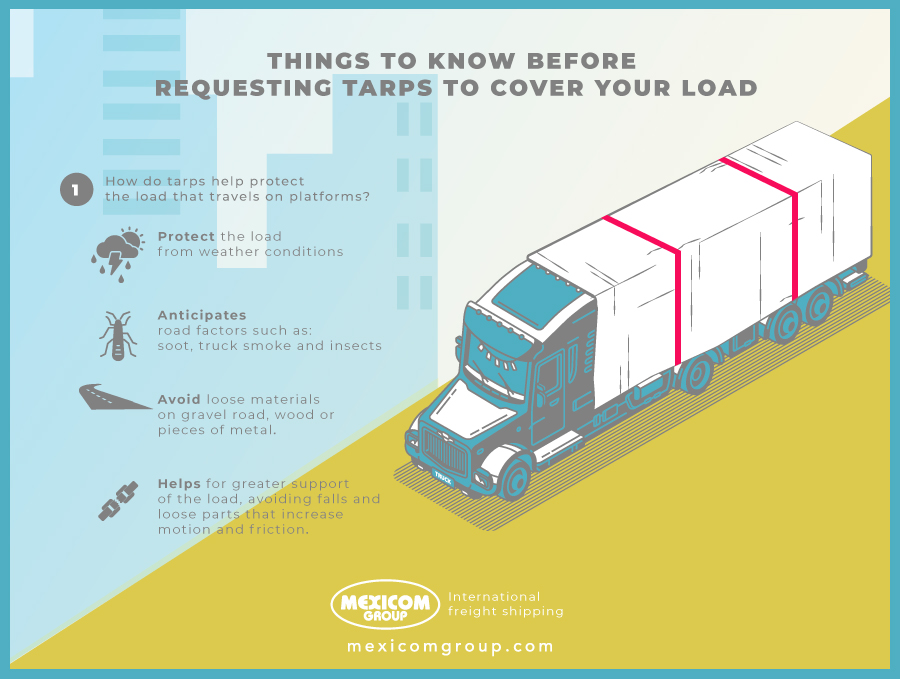
Types of tarps for flatbeds
Tarps are generally classified by the type of cargo they protect.
-
- Lumber Tarps. These tarps are usually made of 18-oz or 14-oz PVC-coated polyester. They must be resistant to water and they must protect the wood from wind, rain, snow, and sun. Lumber tarps have a flap at the end to cover the corners.
The most common sizes for lumber tarps are: 24 ‘x 28’ and 20 ‘x 27’. Approximately two tarps are required to cover the wood that is loaded on a 48 ‘or 53’ flatbeds. However, the exact amount of tarps required to covert the load will be determined once the exact dimensions of the load are known.
- Lumber Tarps. These tarps are usually made of 18-oz or 14-oz PVC-coated polyester. They must be resistant to water and they must protect the wood from wind, rain, snow, and sun. Lumber tarps have a flap at the end to cover the corners.
-
- Steel Tarps. These tarps are usually made of 18-oz or 14-oz PVC-coated polyester. These types of tarps are waterproof and are used to cover materials such as rods, steel sheets, steel cables, etc. The difference between steel tarps and lumber tarps is that steel tarps do not have a flap at the end.
The most common size of steel tarps is 16 ‘x 27’, although it is possible to find tarps of different dimensions, such as: 16 ‘x 16’, 16 ‘x 24’, 16 ‘x 20’, 12 ‘x 27 ‘, 20’ x 24 ‘, 24’ x 24 ‘, 24’ x 30 ‘and 30’ x 30. The number of tarps required to cover a load of steel transported on 48 ‘or 53’ flatbeds will depend entirely on the dimensions of the load. - Coil tarps. Also known as coil bags, these tarps have a rounded shape at the top, to create a fitted cover on steel coils or on any other cylinder-shaped loads. They are made of 18-oz or 14-oz PVC-coated polyester and are water-resistant.
This type of tarp is generally available in the following measurements: 4 ‘to 7’ wide by 4 ‘to 8’ long. As in the previous types of tarps, it is essential to know the specific size of the steel coils to determine the precise size of the tarp that is required to cover the load. - Machinery tarps. This type of tarp is used to protect heavy machinery such as cranes, caterpillars, excavators, backhoes, etc. However, it should be noted that this type of cargo does not always need to be covered with tarps. Machinery tarps are manufactured in 18-oz PVC-coated polyester. The most common sizes of this type of tarp are 24 ‘x 24’ and 30 ‘x 30’. Machinery has varied and irregular shapes and, often, have great height, for these reasons the quantity of tarps required to cover it is variable and will depend on the specific dimensions of the machinery.
Related article: Things to take into consideration when transporting mobile machinery on flatbeds.
- Smoke tarps or nose tarps. This type of tarp is placed in the upper front part of the load in order to protect it from the dust and soot produced by the truck exhaust. They also protect the load of insects. Their sizes vary, but the most common are 10 ‘x 12’ or 12 ‘x 12’. The nose tarps are made to fit the front shape of the load, however, if the load is not rectangular, square, or circular, the nose tarp will not fit perfectly and, in this case, a flat tarp should be used and it will be adjusted with ropes.
- Steel Tarps. These tarps are usually made of 18-oz or 14-oz PVC-coated polyester. These types of tarps are waterproof and are used to cover materials such as rods, steel sheets, steel cables, etc. The difference between steel tarps and lumber tarps is that steel tarps do not have a flap at the end.
The mentioned dimensions are the dimensions of the tarps not of the load they can cover.
Do you really need to tarp your load?
Flatbed tarps are designed to protect the load from weather conditions, such as rain, snow, and UV rays; from insects; from smoke and soot; and from loose materials that can be found on the road such as gravel, wood, or pieces of metal. In addition, they are used to ensure that the load does not fall and to avoid having loose parts that increase movement and friction. If the load requires this type of protection, then it is advisable to tarp it.
However, it is essential to be aware that placing tarps to cover the load is one of the most complicated tasks of transporting merchandise on flatbeds and it is really frustrating for the carrier to be asked to tarp the load just to find that the load is left uncovered outdoors after the unloading. If transporting the load without tarps does not represent any kind of risk of blowing off and won’t damage or injure anyone, then the tarps are not necessary.
Related article: What kind of loads are usually transported on flatbeds?
What should I know before requesting to tarp a load?
Not all tarps are designed to protect all types of loads. The size, quantity, shape, and type of tarp that is chosen to cover cargo will depend on several factors. Before requesting to tarp the load, you should know:
- If the load really should be covered with tarps or not. Remember: if transporting the load without tarps does not represent any kind of risk of blowing off and won’t damage or injure anyone, then the tarps are not necessary.
- The type of load: wood, aluminum, coils, etc.
- If the load should be partially or completely covered. (Maybe only a smoke tarp is required to protect the load from smoke and soot).
- The shape of the load. If the load has irregular shapes, it should be covered with thicker tarps than those used regularly, to avoid perforations in the tarp.
- The exact dimensions of the load. Before requesting to tarp a load, the length, width, and height of the load must be accurately known. The specific measures of the irregular or protruding shapes must be known too.
You might be interested in: Save time and money on freight transportation on flatbeds from Canada and the United States to Mexico.
Make sure your load is properly tarped and well protected, transport cargo on flatbeds, step-decks, and double-drops from Canada and the United States to Mexico with Mexicom Logistics, request a quote today.
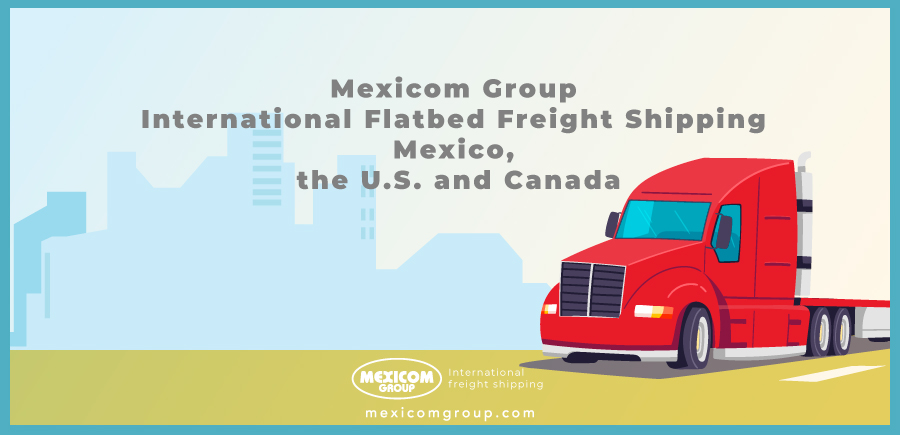



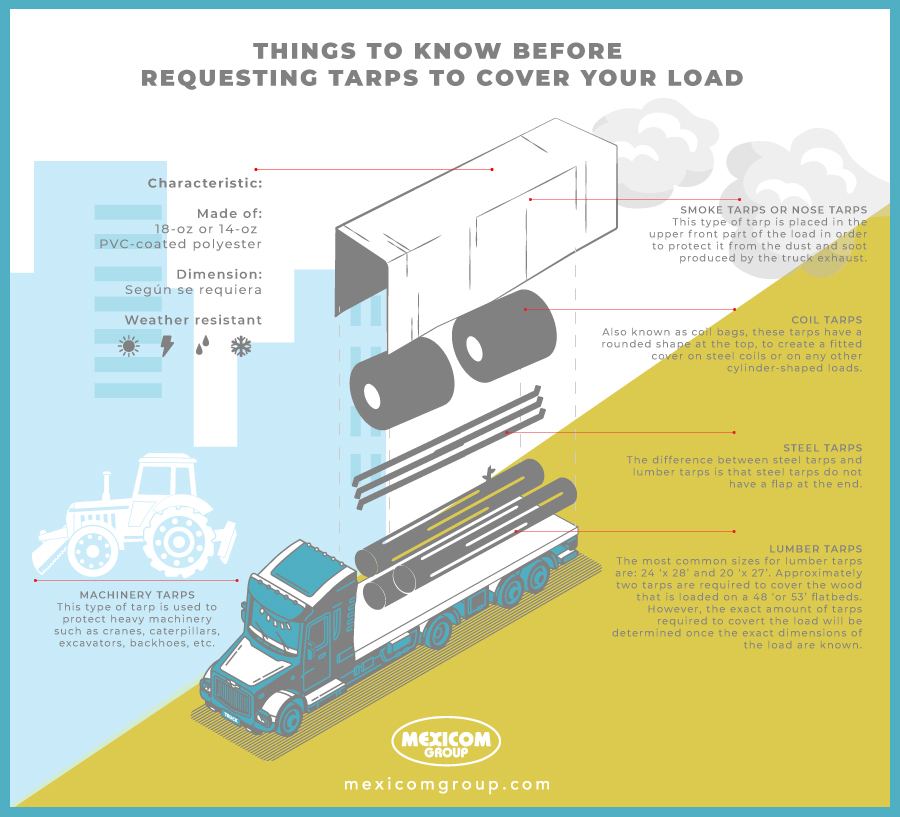
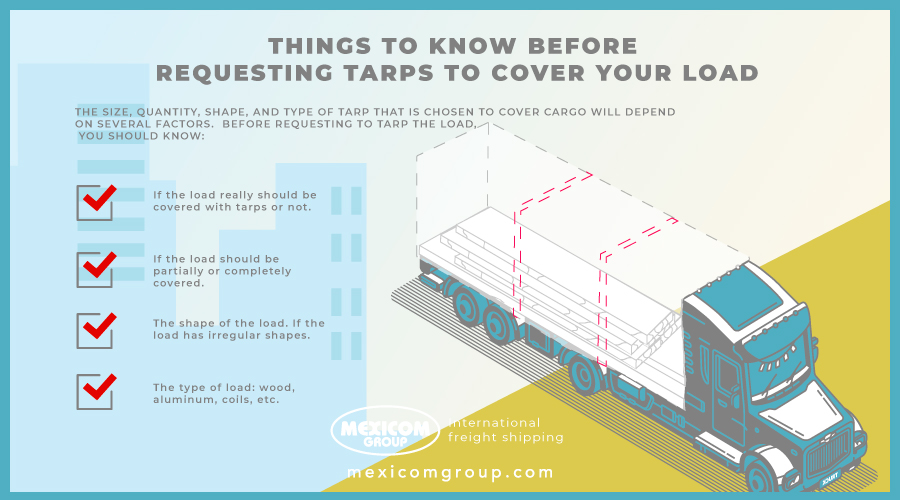





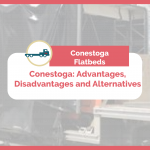
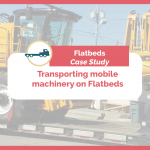
It’s interesting to learn that the shape of the load also affects the type of tarp system that should be used to effectively cover and protect your cargo. As far as I know, nobody would want their tarp to be torn or blown off during a long haul. I’d imagine that a custom-made retractable tarp cover should help secure your goods and be easy enough to install, remove, or store in between trips.
Wow! This is so chock full of useful information, can’t wait to dig deep and start utilizing the resources you have given me. Keep posting!
Great article! Got all the related and required information from this post. Looking forward to your next post!
I like how you explained that you should put a tarp over your flatbed load if it requires protection from the weather conditions or loose materials found on the road. I hope all businesses know this because they might just assume that the trucker will put a tarp on for them. I know truckers know they probably should but if the client doesn’t tell them to, then they most likely won’t do it.
Super heavy weight tarpaulins are made from a special material that gives them thickness. They are widely used because they provide long-lasting protection. They are available in a large variety of our tarpaulins shop. The
super heavy-duty beige/blue tarpaulins are the strongest polythene tarpaulins supplied by us where you need protection against wear and tear. It has eyelets at every fifty meters interval and additional eyelets at the corner to provide greater strength.
It’s good to know that there are five different kinds of tarps for flatbeds, all with different uses. My husband is looking for a new tarp for his truck, and he’s thinking about getting a lumber one. It makes sense considering that he works with lumber all day.